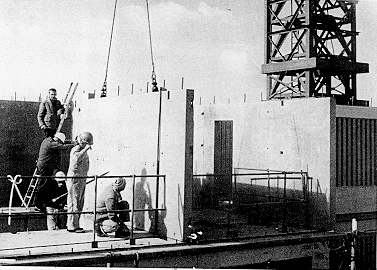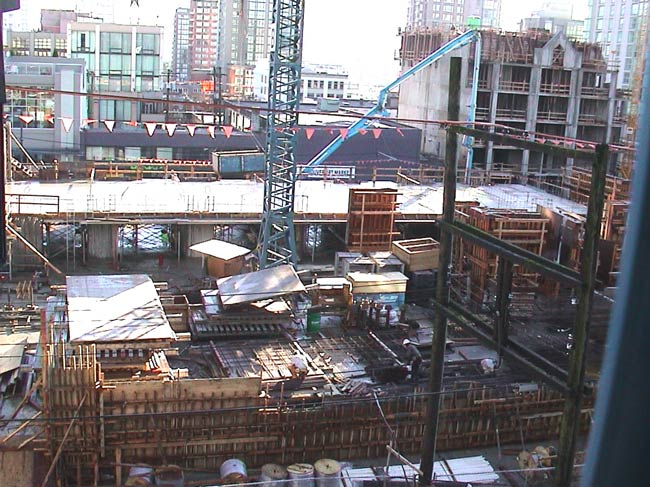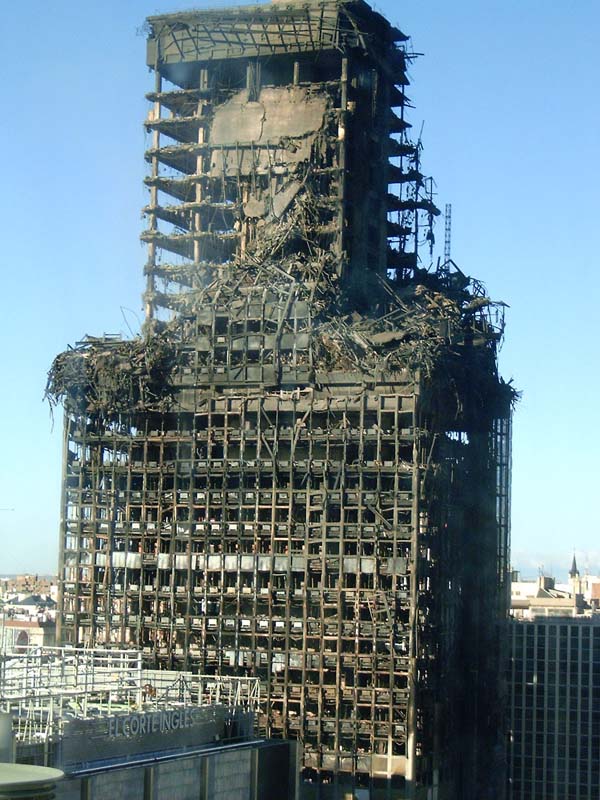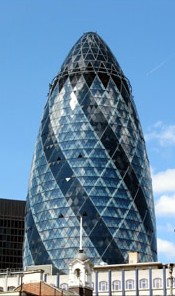The vast majority of the UK residential High rise buildings are built of Reinforced concrete. Some very early buildings used Brick and concrete combinations and the most modern buildings have a higher proportion of Steelwork, but concrete remain the standard material. Other elements may include Brick/Block work, Metalwork, Glass, Plastics, External cladding, constructional skin cladding, Glass/MMM fibre and Woo
CONCRETE
Concrete is an incredibly strong man made mixture of aggregate (sand and gravel), cement and water that has been used in construction since Roman times. It is very hard and in its normal state can withstand high compression loads but it has one major weakness - it cannot resist tension loads, having perhaps a tenth of its compressive strength when it is pulled. So it is good pillars, but not poor for beams. For the last 100 years or so Steel reinforcing wire or bar ( ‘rebar’ ) has been imbedded within the concrete slabs to overcome this weakness. This steel can be placed under tension (either before pouring as pre-tensioned reinforced concrete or after curing , post tensioned reinforced concrete).
Non-tensioned steel reinforced mesh can be also added to add strength the large surface area slabs (typically floors)
A relatively modern addition to concrete has been fibre reinforcement. This can be as a replacement to in addition to conventional steel reinforcement.
Tower block construction in the UK is generally carried out using one (or a combination) of two techniques. Pre-Fabrication (called ‘System’ built) and Pour/Cast On-Site
Concrete Prefabrication (System Built)
 |
A System-built High-rise under construction (1962) |
The earliest form of tower block construction was using the Larsen-Nielsen system. This system was developed in Denmark in 1948. The Larsen-Nielson system was “…composed of factory-built, recast concrete components designed to minimize on-site construction work. Walls, floors and stairways are all pre-cast. All units, installed one-story high, are load bearing (System, 1968).” This building technique encompassed the patterns for the panels and joints, the method of panel assembly, and the methods of production of the panels.. In this type of structural system, each floor was supported by the load bearing walls directly beneath it. Gravity load transfer occurred only through these load-bearing walls. This wall and floor system fitted together in slots. These joints were then bolted together and filled with dry pack mortar to secure the connection.
Following the advent of structural problems and the notable incident at Rowan Point (partial collapse following a small gas explosion) the design integrity of this construction technique has been called into question and since the mid 1980’s it has fallen from favour.
Concrete On Site construction (Pour/Cast in-situ)
 |
A Pour and Cast construction site (1995) |
With this technique the elements of the building are constructed in-situ with hollow forms (moulds). These forms are usually built around a skeleton of steel reinforcing wire or bar (rebar). They then have concrete mix poured into them which encases the steelwork. When the concrete cures (sets) the forms are removed leaving the concrete slab.
Most large scale concrete construction in the world is now carried out using this technique and the liquid concrete can be pumped or craned up buildings as construction progresses. The concrete mixes used in this technique are formulated to an exacting standard and the rebar is usually coated to protect it from corrosion.
Behavior of Concrete in Fire
Many factors will affect how concrete will behave under fire conditions. These may include:
• Quantity and type of aggregate used in the mix
• Thickness (and thus protection of reinforcement)
• Type of Cement used
• Water content of the concrete
• Load bearing
• Fire Exposure time
• Temperature
• Application of water (fire fighting Jets)
• Cladding or covering
• Age
The failure of the concrete slab usually occurs in the form of spalling which is the progressive deterioration of the surface exposed to heat. This is because the Aggregate element usually contain quartz which will start to crack and disintegrate at 600C+
It is the type and quantity of aggregate in the concrete mix that will define its inherent fire resistance properties.
 |
The devistating results of a fire on THe Windsor Tower in Madrid (2005) |
Application of water (fire fighting jets) will cause rapid cooling and a sudden re-hydration of the concrete, causing expansion, this can cause rapid surface erosion of the concrete (4)
As a general guide most concrete, at temperatures of between 400-600C explosive surface spalling can start to occur within 30-60mins. The rapid failure temperature is about 700C.
The failure can be progressive and observable but may also be sudden and unpredictable. Concrete structures (especially load bearing) that have been exposed to a serious or prolonged fire must be treated with extreme caution by Fire crews and expert advice about structural integrity sought ASAP.
Brick (or block work)
Brick is rarely used as the primary construction material in high rise buildings because it has a relatively limited strength under load. In general load bearing walls made of brick seldom extend 10 floors. Brick (or block work) is frequently used to create internal sub-division or as a cladding (in which case it is only bearing the load of its own weight not the entire building).
The manufacturing process of brick involves them being fired in ovens at high temperatures and so they are inherently more stable than concrete when exposed to fire and the Mortar jointing system will allow for movement due to thermal expansion. Brickwork is generally regarded as a good constructional fire resisting material.
Brickwork walls that are load bearing are (pro-rata) much thicker than concrete walls and this thickness also provides for better behavior in fire.
Dry Brickwork does not suffer from spalling in the same way as concrete but failure, although uncommon is hard to predict.
Brick is more predictable in its failure rate than concrete and because it is generally not load bearing, poses less of a problem to Fire crews.
Glass
 |
30 St Mary's Axe, London; affectionatly nicknamed "The Gherkin" A fully glass clad building (2003) |
Glass is a hard, brittle substance, usually transparent, made by fusing silicates under high temperatures with soda, lime, etc. it is brittle and does not stand high impact but its tensile strength can be 5x that of the best steel. This high strength and the development of modern glass construction techniques means that many new high rise buildings use large quantities of glass as walling (usually supports by steel framework). This technique is seldom used in residential accommodation, but all windows will be glass held in by a variety of framing materials
Its melting point is normally 1400 °C to 1600 °C (in some glass this can be as low as 500C) but exposure to high temperatures will cause it to soften and loose strength rapidly. Most un-annealed glass actually contains microscopic stresses (and stress fractures). Sudden exposure to any extreme temperature change, such as Fire or application of cold water jet to hot glass, will cause cracking or complete failure.
Falling glass, either from cracked or broken panes or actual molten glass is a particular hazard to all personnel below the incident. Pieces of glass can ‘plane’ as they fall and travel considerable distances away from the building.
Metals
The three metals commonly used in construction are Iron (usually cast), Steel and Aluminium.
Cast Iron
Cast Iron was widely used in building construction in the 19th Century but its use has been overtaken by Steel. Cast Iron has little strength in tension but is very strong in compression. It can still be found in some older High Rise buildings, usually to provide structural beams and columns.
Steel
Steel is extensively used in all forms of construction and is present in nearly every form of reinforced concrete. Steel is a metal alloy whose major component is iron. Carbon is added and this acts as a hardener. Different mixes of steel will possess different characteristics from varying hardness and malleability to Corrosion resistance and weight.
Its melting point is high at 1300C but it suffers from 3 key failings under fire conditions
• Loss of strength …. at 600C a steel beam may lose two thirds of its strength! (5)
• It is a good thermal conductor …. Meaning it can transfer its heat to involve other materials not directly exposed to fire.
• It has a high thermal expansion….. at 500C a 10 Steel beam can expand 60mm, if this beam was a structural element within a building it may cause collapse. (5)
Because of its limitations in fire, if used in a structural context, steel is usually given additional fire protection, in the form of a sacrificial cladding or a barrier. The steel work buried within reinforced concrete is to a large degree protected from fire by the concrete covering it, but prolonged exposure to high temperature can affect the integrity or the tensioning within concrete, leading to failure.
For fire crews the key safety point in high rise buildings that incorporate any structural steel is that it poses a serious failure risk and whilst the failure of an individual beam may not cause a collapse it is indicative that the buildings structure is being compromised.
Aluminium
Aluminium is a relatively soft and light metal with a melting point of 660C. Its lightness means it has uses in the construction industry for non-structural items, such as door and window frames and external cladding.
Aluminium’s greatest weaknesses is the low temperature at which its structural stability is affected which can be as low as 100-250C, and its high thermal expansion (over twice that of steel)
Where aluminium is used as a framing material it is important to note that exposure to high temperatures will lead to early failure and if these frames form part of the fire resistance of the building (either compartmentation within lobby’s or as windows between floors) integrity can be affected.
Aluminium as an external cladding can melt if exposed to fire and the falling molten aluminium possess additional hazards.
The commonest construction plastics found in the UK are uPVC and Polystyrene.
uPVC
Unplasticised polyvinyl chloride is a lightweight is widely used as a framing and cladding material. It is also extensively used in plumbing as pipe material for waste and rainwater.
It is very durable but weak and like most plastics has a low decomposition temperature (of around 220℃) and will liberate a large amount of acrid smoke.
It has been extensively user in the refurbishment of many UK tower blocks from the 60’s and 70’s to provide double glazed windows and balcony doors.
Polystyrene
Polystyrene is primarily used as an insulation material as it has a very low thermal transferee rate. When used in construction it is usually treated to have a degree of fire resistance. Once it starts to decompose due to fire it melts and liberated large quantities of acrid smoke.
It can be found in floor slabs and within wall structures. Is is also used as a lagging or insulation material within the buildings services.
During the renovation some of the UK’s older Tower Blocks a retro fitted Polystyrene external layer has been fitted and this in turn is then rendered with a layer of Cement. Although the cement layer provided surface fire resistance (class 0) its behavior in a serious large scale incident remains untested. (8).
Natural and Man Made Mineral Fibres
These materials are used as an insulation material and may be found insulation exposed steel work or in use as a lagging or insulation material within the buildings services. These materials are very fire resistant, but once they start to decompose, the air-born partials pose a significant health hazard.
Many Buildings have had extensive surveys to look for existence of Mineral Fibres (primarily Asbestoses) and in most cases the higher risk fibres have been removed from buildings, but there still exists in many buildings from 60/70’s significant quantities of mineral fibre (usually in board format) that will expose a serious risk in fire.
.